Germany – Berlin August 31- Sept 2, 2019
Liebermann Villa am Wannsee. In the NM “House Museums/Plantations” series, this was the summer home on Lake Wannsee of the famous modern German artist Max Liebermann (1847-1932). Built in 1910, he created 220 paintings in the garden, a carefully planned space by Lieberman. At his death, it was confiscated by the Nazis and used as a hospital and sports clubhouse and renovated between 2002-06. The garden is a magnificent collection of vegetables and flowers. The house shows his recreated furnishings and some art. The long front lawn continues down to the lake shore. €8, no reduction
House of the Wannsee Conference. In the NM “The Dark Side” series, this was an industrialist’s villa built in 1915 and used by the SS as a conference centre and guest house from 1941-45. On January 20, 1942, 15 high-ranking representatives of the SS, the NSDAP and various ministries met to discuss the planned deportation and murder of European Jews. It was chaired by Reinhard Heydrich, head of Reich Security. The SS presented campaigns and their killing methods already carried out since August 1941 in the Soviet Union. The deportation expert, Adolf Eichmann drew up the protocol found in 1947 that documents with alarming clarity the plan to murder all European Jews.
The exhibit documents the prehistory of Jewish persecution, the deprivation of rights and expulsions from 1933-39, the deportations, ghettos and murder. Free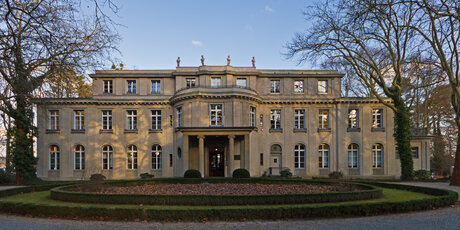
Day 2
I had a busy museum day as again I bought the Berlin Welcome Card with a Monday as my second day so had to see a lot on the Sunday. But started the day at 7am with a big drive about to see many things in SW Berlin. Berlin is a big city with big driving distances, but at 7, the streets were empty.
Berlin Welcome Card. It comes in several editions, but I purchased the “All Inclusive” version that gave free admission to several museums instead of simple discounts as in the normal card. I also foolishly added the transportation, unnecessary as parking in Berlin is so easy. Sites in the city are very spread out, it is not a city that you can walk everywhere.
A real advantage is being able to skip all the queuing for tickets. The card is usually shown at the beginning of exhibits not the ticket desk.
Includes 17 museums (+ discounts, usually 25%, at many others), 6 attractions, many sightseeing, boat, bicycle and guided tours and discounts at restaurants and shopping. €79 (€10 for the transportation)
Adlermühle (Mariendrof Eagle Mill), Mariendorf. This is not the Croatian restaurant, but is located at the Swim Club Friesen. One wing of the vanes has been removed because of rotting wood. Built as Lohmuhle in 1759, it worked to shred tree bark and tanning animal skins. A Dutch mill, it was moved in 1888 with a 8-sided superstructure built and the truss top simply put on top. It worked again operating on wind power until 1931, then electric drive until 1959. A swimming club Friesen established a swimming club in it in 1968. It is about 2 blocks SW of the restaurant. It is an 8-sided brick bottom, a balcony and the black shingles with a black cap. One vane is missing.
Britzer Mühle. Sitting in a nice field behind the Britzer Restaurant, it appears to be well maintained. Built in 1885, it has a brick base and tall shaked top with a Dutch cap and 4 nice vanes. It appears that it can’t be visited.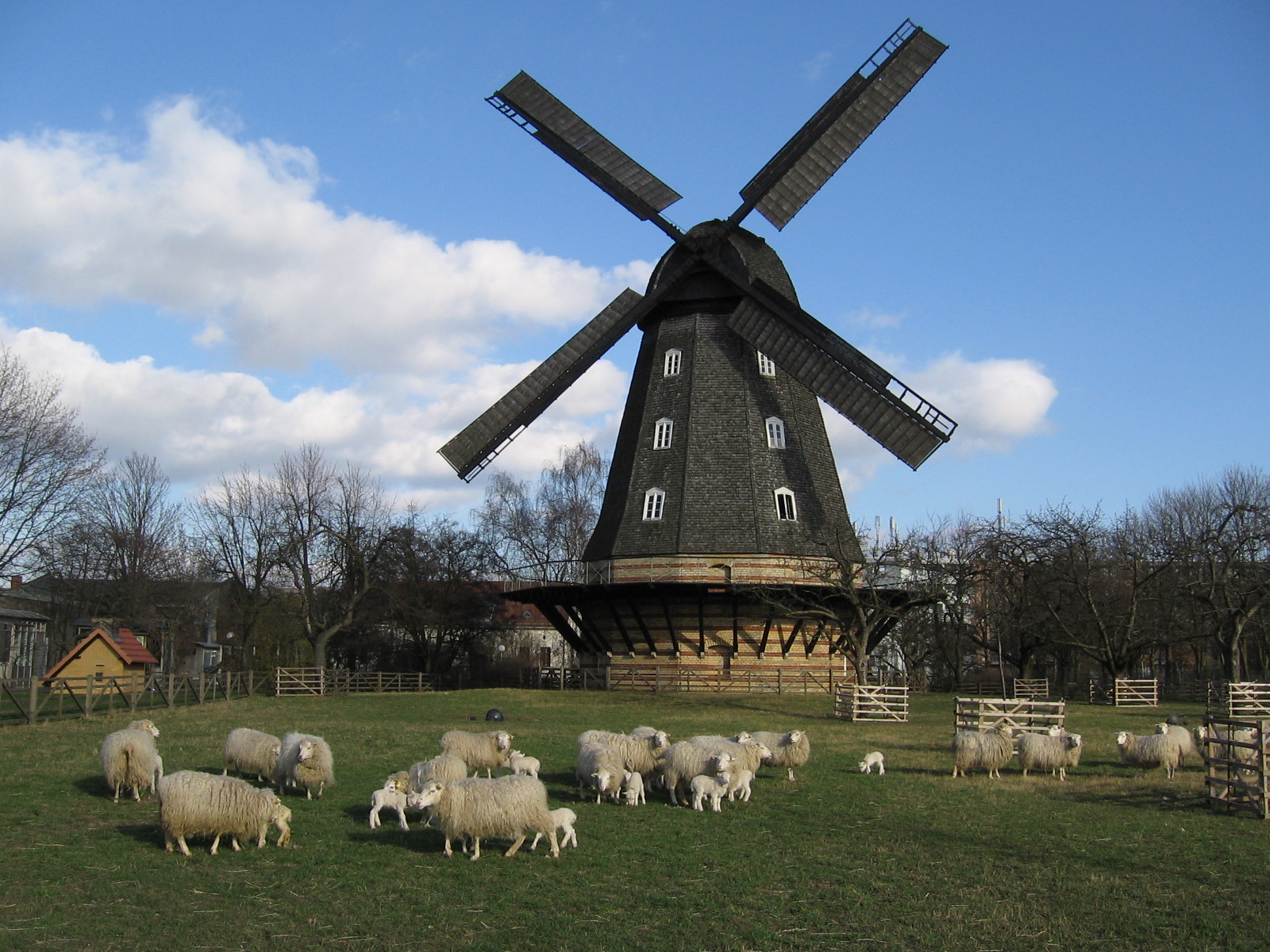
Gropius Passagen. This huge, newly renovated shopping mall in south Berlin, features the usual shops including some not found in other malls, a supermarket, good food, cheap parking and is very popular with Berliners, although so large, some people find it confusing.
Jungfernmühle, Buckow. Now occupied by the Wiesenstein Restaurant on all 4 floors, it has an 8-sided 2-story brick bottom and a weathered shake hexagonal 3rd and 4th stories topped with a rotating Dutch top. All the vanes are present but are empty. There is no information on the mill on the outside.
Schloss Britz. This relatively small 2-story, yellow manor house is used as a music venue for shows about once per week. The restaurant in the basement is open daily. Not open to the public.
BERLIN MODERNISM HOUSING ESTATES
A WHS (2006), these are 6 subsidized house estates dating from the years of the Weimar Republic (1919-1933) when the city was progressive socially, politically and culturally. They contributed to improved housing and living conditions for people with low incomes though innovative architecture (fresh design, technical and aesthetic) and urban planning.
Gartenstadt Falkenberg – Bohnsdorf (1913-1916)
Siedlung Schillerpark – Wedding (1924-1030)
Wohnstadt Carl Legion – Prenziauer Berg (1928-1930)
Weiβe Stadt (White City) – Reinickendorf (1929-1931)
Groβsiedlung Siemensstadt – Charlottenburg-Nord (1929-1934)
Groβsiedlung Britz – Britz (1925-1930). One of the WHS Berlin Modernism Housing Estates, this is a small grouping of 37 joined 3-story, red plastered apartments with dormer windows in the roof 3rd story. The only distinguishing features are the brick entrances.
Internationales Congress Centrum Berlin. Opened in 1979, it is one of the largest conference centres in the world at 320m long, 80m wide and 40m high and a landmark of post-war German architecture. It was closed in 2014 because of asbestos contamination. Kaiser Wilhelm Memorial Church. Built in 1895, the entire nave of the church was destroyed in an allied bombing raid in 1943. Only the tower remains and all the windows, even its rose window, is empty. Inside the tower though are wonderful gilt mosaics of florals and bible scenes.
In front is the 8-sided, 6-story modern memorial church built in 1961 – inside the entirely open design has each of the 8 sides composed of 25 squares of 56 small blue stained glass windows. The crucifix is a lovely large bronze Christ with his arms spread and leaning outwards toward the congregation. Sunday service is at 10 and 6. Free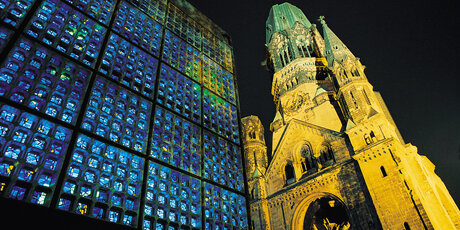
KaDeWe (Kaufhaus des Westens). It is the second largest department store in Europe after Harrods in London. It was founded in 1907. An American bomber crashed into it in 1943 and it reopened in 1950 and all 7 floors reconstructed in 1957. Another floor was added in 1996 and renovated again between 2004-7. Each floor has different merchandise with many luxury brands. 1st men’s, 2nd women’s fashion, 3rd shoes and leather goods, lingerie, 4th interior design, 5th books, electronics, toys, 6th and 7th food with 110 cooks and 40 bakers serving 30 gourmet counters, 8th 1000-seat restaurant and winter garden.
Victory Column. Built in 1873 to commemorate the Prussian victory in the Danish-Prussian War. By the time it was finished, Prussia had also defeated Austria in the Austro-Prussian War (1866) and France in the Franco-Prussian war (1870-71), giving the monument new purpose. In the middle of a large circle, this impressive monument has a winged bronze sculpture of Victoria, 8.3m high and weighing 35 tons. It sits atop a 4-segment solid sandstone column decorated with cannon barrels on 3 segments and golden garlands on the fourth, that is on top of a red granite columned building with a glass mosaic that stands on a large red granite base decorated with four bronze bas reliefs showing the three wars and the victorious marching of the troops into Berlin.
It originally sat in Konigsplatz in front of the Reichstag but was relocated in 1939 by the Nazis and its height augmented by another 7.5m giving it an overall height of 66.89m. it survived WW II without much damage due to its benign new location.
It is accessible by four tunnels and the 281 steps can be climbed to a viewing platform almost at the top of the column.
Barack Obama gave a speech from it in 2008.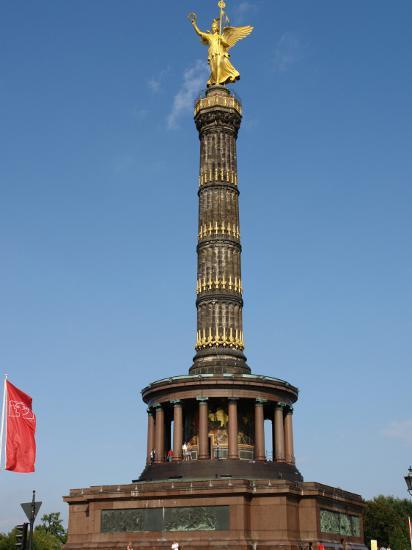
Day 2
Berlin Hbf. The Berlin Central Train Station/Bus station, it is a huge modern glass-roofed building connecting two parallel buildings. I bought my Berlin Welcome Card here at Tourist Information just inside the north entrance.
Hamburger Bahnhof (Museum for Contemporary Art). Large exhibit by Jack Whitten (1939-2018), a black American artist: unique glass mosaics, sculpture as painting. €14*
Natural History Museum. Exhibits on meteorites, dinosaur fossils (a full-size T rex) and lots of stuffed animals in nice dioramas. English variable. €10, 5 with Welcome card
MUSEUM ISLAND (Museumsinsel). A WHS, it has 300 years of architecture – Classical, Neo-Baroque, Bauhaus and Art Deco. There are many museums on the island. Alte Nationalgalerie (Old National Gallery). Major exhibit on Emile Nolde (1861-1956), the artist with the most confiscated art by the Nazis.
Altes Museum (Old Museum). Greek, Etruscan and Roman art. Great Scythian gold hordes.
Bode Museum. In a fantastic building full of marble and domes, this is on the west end of Museum Island (access only from the streets at the end, not via the island). It is full of not so interesting religious and Renaissance art.
Museum for Communication. Originally the postal museum, it now deals with all elements of communication in many excellent small exhibits. €6, 3 with Welcome Card
The next four museums are all in the same complex.
Neue Nationalgalerie (Kulturforum). This modern art museum closed in 2015 for “several years” of renovation.
Gemäldegalerie. Old Masters, mainly religious art and some 17th and 18th century European art.
Museum of Prints and Drawings (Kupferstickabinett Berlin). On the 2nd floor of Gemaldegalerie. Exhibit on typology.
Museum of Decorative Arts. Lots of spectacular old furniture with amazing inlays. Silver, porcelain. Temporary exhibit call “African Futures” about African style re hair and clothes. €8, 4 with Welcome Card
Berggruen Museum. Presents the art of Heinz Berggruen (1914-2007), an art dealer and collector who donated his collection to this museum. There are 120 Picasso’s plus Cezanne, Klee and Matisse. Picasso could actually draw.
Dali, The Exhibition at Potsdamer Platz. I have seen many Dali exhibits and this large one added to the collection. €10
Sony Center. This Sony-sponsored building at Potsdamer Platz opened in 2000 and houses Sony’s German headquarters. Most of the buildings were destroyed in WW II and from 1961, most of the area became part of the No Mans Land of the Berlin Wall, resulting in the destruction of the remaining buildings. Costing €750 million, Sony sold it to a group of US and German investment funds in 2008 for €600 million who sold it to the National Pension Service of South Korea in 2010 for €570 million.
It contains a mix of shops, restaurants, a conference center, hotel rooms, art and film museums, cinemas, an IMAX, a Legoland Discovery Center and a Sony Style store.
Museum of Photography. The entire exhibit was on Helmut Newton, a fashion photographer for French Vogue (his biggest job, but had many others). €10*
Berlin Zoologischer Garten Station. Has trains (airport, Olympic Stadium, Spandau), a metro, McDonalds, bookstore with some English books, convenience store – all you need if a traveler.
Das Klo Bar (KLO). In the NM “Bizzarium” series, this is a lively bar with cozy bench seating, a toilet theme and wild, electric décor serving pub grub. Plays 70s and 80s music. Full of gimmicks (you get sprayed in the face with water when you enter, monsters drop from the ceiling). Lots of fun.
Ibn Rushd-Goethe Mosque. Describing itself as a liberal mosque (bans face-covering, women are not obligated to wear a headscarf, allows men and women to pray together, accepts both Shia and Sunni Moslems, and accepts LGBT worshippers) and is possibly the first mosque of its kind in Europe as well as the entire world. It was founded by a German lawyer of Kurdish-Turkish descent in 2017. She has been condemned by both Turkish and Egyptian religious authorities and received about 100 death threats since opening. It is named after the Andalusian-Arabic polymath and the German writer and statesman Goethe.
Unusually, the mosque is located on the 3rd floor at the back of the St Johanniskirche Church. There is a small sign on the back door and a buzzer to let you in. Its hours are few: Mondays at noon, Friday Prayer at 2pm, yoga and brunch on Sundays at noon.
Fernsehturm Berlin (Berlin TV Tower). This 368m tower was opened in 1968. There is a viewing gallery at 203m with every compass point giving details of what is below. If one were to read it all, you would get almost the entire history of Berlin. A revolving restaurant is at 207m. Come at opening or late to avoid the long ticket queues. €16.50*
Liberacion. This once very popular nightclub/bar is now permanently closed and covered with graffiti.
Day 3
Berlin Ostbahnhof Station. One of the main train stations in Berlin, this has 11 gates, metro access and 3 levels of shops and restaurants including a supermarket.
Kino International. This cinema was built in the early 60s in the GDR and held film premiers. Built in modern style with a glass front and geometric patterned tiles on the sides, it still has an important role in festivals such as the Beriner Berlinale.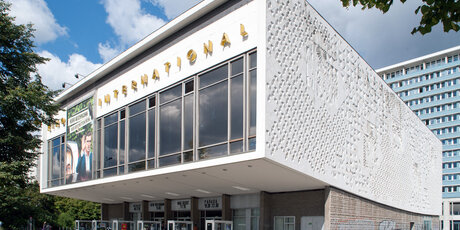
Berlin Friedrichstrasse Station. Another one of Berlin’s main train stations with 5 gates, a metro station and the usual shops and restaurants. In the middle of the city.
JOH 3. In the Modern Architecture Building series, this small 5-story building has a glass front covered with bronze coloured metal vanes that is all curves. Has vacancies on the bottom.
Mein Haus Am See. Combined café, bar and restaurant open 24 hours with a full menu and reasonable prices. Outdoor seating.
Arkonaplatz. This is a Friday farmer’s market.
Mauerpark Flea Market. A typical flea market.
Rykestrasse Synagogue. Built in 1904, it became a private Jewish school in 1929. It was closed by the Nazis in 1941 and not opened again as a school until 1999. The building is a 5-story red brick building with 2 arches closed by metal gates and 24 hour/day police guards.
Visiting is only possible on Friday evenings at 7pm – arrive 30 minutes to join the prayers in the synagogue that you are expected to stay for the duration. There are also steel columns surrounding an area around the front of the synagogue. Free
Sealife and Aquadom. All small displays with bubble windows. Some interesting fish. The Aquadom is a ride that descends through a cylinder. €19*
DDR Museum. All about the GDR (East Germany). In 1946, the Communist Party of Germany (KPD) and the Social Democratic Party of Germany (SDD) merged to form the Socialist Unity Party of Germany (SED) and remained in power until 1989. In a position of power, they were based on forced threats, rewards and privilege, controlling everything (including elections) but the churches. They used the Ministry of State Security (MfS) to secure the SED dictatorship. On May 8, 1945, Germany and Berlin were divided into 4 zones of occupation – France, Britain, USA and the Soviets. After October 1949, the Soviets controlled the SED and GDR.
Has great displays showing life in the GDR. The Trabant was a car had no cooling system or fuel gauge, was terribly unreliable and required self repair and had a 2-stroke engine that required an oil mixture for fuel. Showed many products, the interior of homes, discussed the large role sports played, how hard it was to get goods and class distinction between the normal people and the Stasi. There was no unemployment and wages were relatively high but there was nothing to buy.
MUSEUM ISLAND
Berliner Dom. On Museum Island, the present Baroque building dates to 1894 and it was restored in 2018. The crypt contains tombs of the ruling Prussian monarchs of Brandenburg, the Hohenzollerns. €6
James Simon Gallery. This is all very confusing. This is not a gallery but simply the grandiose entrance to the Pergamon and Neues Museum. There was one small exhibit on making plaster casts for statues. There is no fee for this gallery.
Pergamon Musuem. “Architecture from Antiquity”. The highlight is the Ishtar Gate from Babylon that was excavated by the Germans in 1899-1917 and representing the time of Nebuchadnezzar II (604-562 BC). Pass through Procession Street, a 50m long corridor of brilliant coloured tiles 3m high, all blue and yellows with lions. The gate itself is huge and covered with the same tiles but an array of animals, 10 to a side. It is backed by a Roman gate of double columns and carved friezes.
The 2nd floor is Islamic art, many carpets and an Aleppo room, a fantastic painted room with peacocks and people among all the geometrics.
Requires an entry time.
Neues Musuem. In the basement of the James Simon Gallery, this is the 2nd oldest museum (from 1813) on the island, most in lovely brick domed vaults. It has Egyptian art, much from the N Sudan expedition of 1842-45. Includes a papyrus collection. Very spread out and I’ve seen much better Egyptian museums.
Stasi Museum. See the history above in the DDR Museum and Berlin Wall Museum. The MfS (Stasi) employees could not have had Nazi affiliations, relatives in West Germany, many had been persecuted by the Nazis or had had Soviet military or secret police training. They propagated heavy propaganda against the West. The employees had special hospitals, shops 18,000 flats, 300 recreation facilities and other special privileges. The facilities used by them grew from one building to 54 acres with 50 office buildings with House 1 (the museum) being the main office. There were 91,000 officers employed and 180,000 informers worked for them. They infiltrated every aspect of East German society using phone taps and monitoring devices. 250,000 citizens were jailed. The inner German border was 1,378kms long. €8*
Skatehalle. In a rough neighborhood of old brick warehouses covered in graffiti, this skate park is in a large warehouse with a steel truss roof. It consists of ramps, rails, stairs and seating.
Ramones Museum. This is a café/bar/restaurant with a museum in the back. See many photographs, posters, album covers, watch videos and hear music of the New York pop group. I wanted to buy a T-shirt but at €28, I declined. Museum €5
Jewish Museum. The permanent exhibitions were being renovated. The temporary on was called “This Place” with 12 photographers who had photographed Israel since 2010. Some nice photos but very sterile as not one of the wall or documenting its disastrous effect on Palestinians. In the basement, many small vignettes about Jewish life in Germany primarily around WW II. I learned nothing new. Would have like more info on what has happened to Jews in Germany since. As usual a bunch of police outside for security. €8
Mauermuseum (Berlin Wall Museum). Between 1949 and 1961, 2.7 million East Germans left for the west primarily through West Berlin. To stop the intellectual and manpower drain, they built the Berlin Wall that was completed in August 1961, preventing all access to West Berlin. 65,000 people woke up with no access to their jobs.
The wall completely encircled West Berlin averaging about 100m wide: 127.5kms of alarmed fence, 124.3kms of patrol road, no man’s land with a strip of sand showing any footprints and then 156.4kms of the steel reinforced concrete border wall. The wall was 3m high, made of reinforced concrete with a steel pipe over the top preventing pulling one up and a concrete foot pointed into the border strip to prevent vehicles from toppling a section. There were 302 observation towers with guards instructed to shoot to kill anyone in the border area. 136 eventually died trying to cross, 92 of them shot.
Checkpoint Charlie was the only crossing. Automatic guns were set up that were only removed after international objection in 1983. The major demonstration occurred in Leipzig in Oct 1989 with 70,000 demonstrators.
The border finally opened on Nov 9, 1989.
Berlin Wall remnants. I saw the piece of wall from Potsdamer Platz (the part of the Berlin Wall next to West Berlin – covered in graffiti on the west side) that was in the Black Box museum lot.
The other sections of wall remaining are at Niederkirchnerstraβe, the Berlin Wall Memorial on Bernauer Straβe and three observation towers. In several places, there is a double row of cobbles crossing streets and sidewalks marking the location.
This area around the Friedrichstraβe Border Crossing (Checkpoint Charlie) is wildly touristed. In the cold war, Soviet and American tanks faced off each other at the checkpoint. Only West German citizens and foreigners were allowed to cross at Mossehaus (Mosse-Zentrum Service GmbH). In the NM “Modern architecture buildings” series, this small office building has a total glass front covered by a bronze aluminum grill with curved holes to indicate windows.
Brandenburg Gate. One of the iconic Berlin sights, this was built in 1793 as a neoclassical monument built by the Prussian king Frederick William II to represent peace as a triumphal arch. It was built on the site of a former city gate (one of the 18 gates in the Berlin Customs Wall) that marked the start of the road from Berlin to Brandenburg and the entry to the renowned boulevard of linden trees that led directly to the royal City Palace of the Prussian monarchs. Throughout its existence, it has been considered a symbol of the tumultuous history of Europe and Germany but also of European unity and peace.
The gate consists of twelve Doric columns, six to each side, forming five passageways. Atop the gate is a Quadriga, a chariot drawn by four horses ridden by Victoria equipped with a Prussian eagle and iron cross on her lance with a wreath of oak leaves.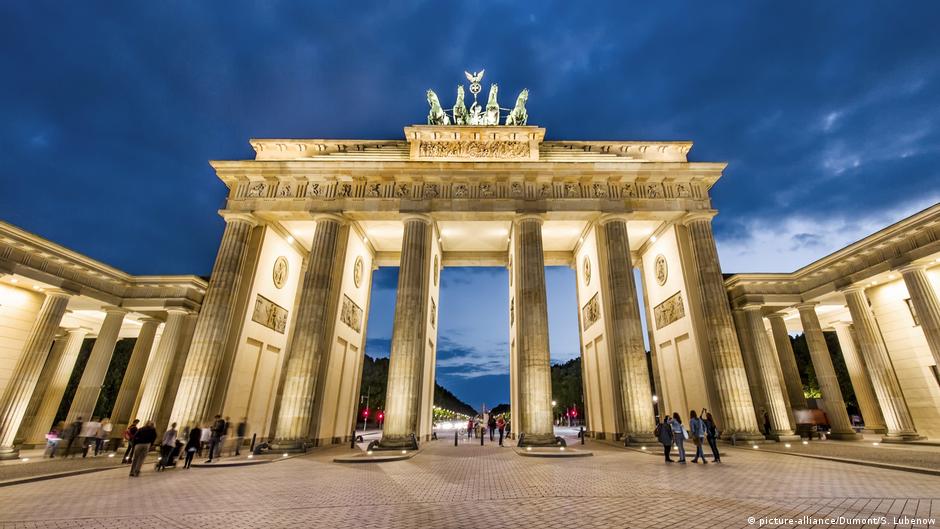
After Napoleon defeated Prussia in 1806, he took the Quadriga to Paris, but it was returned when the Prussians occupied Paris in 1814. The Nazis used the gate as a party symbol. It was damaged in WW II with bullet holes in the columns and only one horses head surviving. After the war, it was in East Berlin and closed when the Berlin Wall was built in 1961 until 1989 when it symbolized freedom and the desire to unify the city of Berlin. The wall around it was demolished the following year. It was extensively refurbished from 2000-02.
At the official ceremony on the reunification of Germany in 1990, the flag of the new German republic was raised over the gate. On the 20th anniversary of the fall or the Berlin Wall in 2009, 1000 – 2.5m tall dominoes were toppled in stages converging here. When Germany won the 2014 FIFA world cup, the German National Team held their victory rally in front of the gate.
New Synagogue. With its imposing dome, it was built in 1860 and was the largest synagogue in Germany. It was severely damaged in WW II and rebuilt since 1996, now holding a museum on Jewish life. It had several police officers outside who seem to function only as parking cops. €6
Olympic Stadium. Built in 1913 for the cancelled 1916 Olympics, it was renovated for the 1936 Olympics and again recently when a new roof was installed.
Before I left Berlin, I was fortunate to be able to get new tires. I had been told at my 30,000 kilometer oil change in Serbia that I needed new tires and now had exactly 60,000 kms on the odometer, so they were pretty beat. I had looking for these specific tires in previous cities to no avail. Apparently the police give fines if the wear bar on tires is visible. I dropped into a tire shop at 6pm and was out by 7:45. €608
I decided to make a long road trip along the Poland border to see all the XL sites in both Germany and the ones I had missed in Poland. Most were twinned cities opposite each other and easy to visit both.
GO TO Germany – Brandenburg (Potsdam, Cottbus)
NOMAD MANIA Germany – Berlin
World Heritage Sites
Berlin Modernism Housing Estates
Museumsinsel (Museum Island), Berlin
Palaces and Parks of Potsdam and Berlin
Sights (Temporarily Reinstated)
Berlin Wall
Berlin Zoo
Checkpoint Charlie, Berlin
Kaiser Wilhelm Memorial Church
Reichstag Building
European Cities
BERLIN World Cities and Popular Towns
Airports: Berlin – Tegel (TXL)
Railway, Metro, Funiculars, Cable Cars
Berlin Friedrichstrasse Station
Berlin Gesundbrunnen Station
Berlin Hbf
Berlin Ostbahnhof Station
Berlin Trams
Berlin U-Bahn
Berlin Zoologischer Garten Station
Museums
Alte Nationalgalerie
Altes Museum
Berggruen Museum
Berlinische Galerie
Bode Museum
DDR Museum
Egyptian Museum of Berlin
Gemäldegalerie
German History Museum
German Museum of Technology
Hamburger Bahnhof
James Simon Gallery
Jewish Museum
Käthe Kollwitz Museum
Mauermuseum
Museum for Communication
Museum for Islamic Art
Museum of Decorative Arts
Museum of European Cultures
Museum of Photography
Museum of Prints and Drawings (Kupferstickabinett Berlin)
Natural History Museum
Neue Nationalgalerie (Kulturforum)
Neues Museum
Pergamon Museum
Ramones Museum
Scharf-Gerstenberg Collection
House Museums/Plantations: Liebermann Villa
Castles, Palaces, Forts
Charlottenburg Palace
Köpenick Palace
Schloss Britz
Spandau Citadel
Religious Temples
Berliner Dom
Ibn Rushd-Goethe Mosque
Kaiser Wilhelm Memorial Church
New Synagogue
Rykestrasse Synagogue
Modern Architecture Buildings
BBI Info-Tower
Fernsehturm Berlin
Internationales Congress Centrum Berlin (permanently closed)
JOH 3
Kino International
Mossehaus (Mosse-Zentrum Service GmbH)
Olympic Stadium
Sony Center
Festivals
Berlin ERLEUCHTET
Berlin Film Festival
Berlin: Berlin Independent Film Festival
Berlin: Berlin Short Film Festival
Berlin: Prix Europa
Carnival of Cultures
Theater der Welt (Theatre of the World)
Entertainment/Things to do
AquaDom, Berlin
Berlin Zoo
Cosmic Comedy Berlin
Eshther Schipper
EXITR – Live Adventures
Liberacion (permanently closed)
Mein Haus Am See
Skatehalle
THE ROOM
Zoos
Berlin Zoo (Tiergarten)
Berlin-Friedrichsfelde Zoo (Tierpark Berlin)
Botanical Gardens: Berlin Botanical Garden
Aquariums
AquaDom
Aquarium Berlin
Planetariums
Planetarium am Insulaner
Zeiss Major Planetarium
Windmills
Adlermühle
Britzer Mühle
Jungfernmühle
Buckow: Jungfernmühle
Mariendorf: Adlermühle
Malls/Department Stores
Gropius Passagen
KaDeWe
Markets
Arkonaplatz
Mauerpark Flea Market
Monuments
Brandenburg Gate
Victory Column
Vehicle Museums: Berlin: Trabi Museum
The Dark Side
Berlin Wall remnants
Cold War Nuclear Bunkers
House of the Wannsee Conference
Stasi Museum
Topography of Terror
Bizzarium: Das Klo Bar
